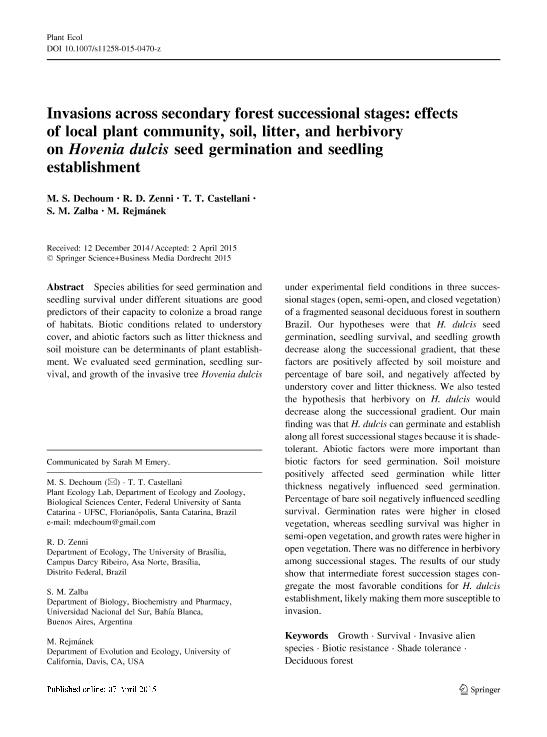Mostrar el registro sencillo del ítem
dc.contributor.author
Dechoum, Michele
dc.contributor.author
Zenni, Rafael D.
dc.contributor.author
Castellani, Tania
dc.contributor.author
Zalba, Sergio Martín

dc.contributor.author
Rejmánek, M.
dc.date.available
2018-04-03T20:51:46Z
dc.date.issued
2015-03
dc.identifier.citation
Dechoum, Michele; Zenni, Rafael D.; Castellani, Tania; Zalba, Sergio Martín; Rejmánek, M.; Invasions across secondary forest successional stages: effects of local plant community, soil, litter, and herbivory on Hovenia dulcis seed germination and seedling establishment; Springer; Plant Ecology; 216; 6; 3-2015; 223-233
dc.identifier.issn
1385-0237
dc.identifier.uri
http://hdl.handle.net/11336/40585
dc.description.abstract
Species abilities for seed germination and seedling survival under different situations are good predictors of their capacity to colonize a broad range of habitats. Biotic conditions related to understory cover, and abiotic factors such as litter thickness and soil moisture can be determinants of plant establishment. We evaluated seed germination, seedling survival, and growth of the invasive tree Hovenia dulcis under experimental field conditions in three successional stages (open, semi-open, and closed vegetation) of a fragmented seasonal deciduous forest in southern Brazil. Our hypotheses were that H. dulcis seed germination, seedling survival, and seedling growth decrease along the successional gradient, that these factors are positively affected by soil moisture and percentage of bare soil, and negatively affected by understory cover and litter thickness. We also tested the hypothesis that herbivory on H. dulcis would decrease along the successional gradient. Our main finding was that H. dulcis can germinate and establish along all forest successional stages because it is shadetolerant. Abiotic factors were more important than biotic factors for seed germination. Soil moisture positively affected seed germination while litter thickness negatively influenced seed germination. Percentage of bare soil negatively influenced seedling survival. Germination rates were higher in closed vegetation, whereas seedling survival was higher in semi-open vegetation, and growth rates were higher in open vegetation. There was no difference in herbivory among successional stages. The results of our study show that intermediate forest succession stages congregate the most favorable conditions for H. dulcis establishment, likely making them more susceptible to invasion.
dc.format
application/pdf
dc.language.iso
eng
dc.publisher
Springer

dc.rights
info:eu-repo/semantics/openAccess
dc.rights.uri
https://creativecommons.org/licenses/by-nc-sa/2.5/ar/
dc.subject
Invasiones BiolÓGicas
dc.subject
Resistencia BiÓTica
dc.subject
Bosque Caducifolio
dc.subject
Establecimiento
dc.subject.classification
Otras Ciencias Biológicas

dc.subject.classification
Ciencias Biológicas

dc.subject.classification
CIENCIAS NATURALES Y EXACTAS

dc.title
Invasions across secondary forest successional stages: effects of local plant community, soil, litter, and herbivory on Hovenia dulcis seed germination and seedling establishment
dc.type
info:eu-repo/semantics/article
dc.type
info:ar-repo/semantics/artículo
dc.type
info:eu-repo/semantics/publishedVersion
dc.date.updated
2018-03-28T18:07:32Z
dc.journal.volume
216
dc.journal.number
6
dc.journal.pagination
223-233
dc.journal.pais
Alemania

dc.journal.ciudad
Berlin
dc.description.fil
Fil: Dechoum, Michele. Universidade Federal de Santa Catarina; Brasil
dc.description.fil
Fil: Zenni, Rafael D.. Universidade do Brasília; Brasil
dc.description.fil
Fil: Castellani, Tania. Universidade Federal de Santa Catarina; Brasil
dc.description.fil
Fil: Zalba, Sergio Martín. Universidad Nacional del Sur. Departamento de Biología, Bioquímica y Farmacia; Argentina. Consejo Nacional de Investigaciones Científicas y Técnicas; Argentina
dc.description.fil
Fil: Rejmánek, M.. University of California at Davis; Estados Unidos
dc.journal.title
Plant Ecology

dc.relation.alternativeid
info:eu-repo/semantics/altIdentifier/doi/http://dx.doi.org/10.1007/s11258-015-0470-z
dc.relation.alternativeid
info:eu-repo/semantics/altIdentifier/url/https://link.springer.com/article/10.1007%2Fs11258-015-0470-z
Archivos asociados
